 |
|
Digits & Dragons by Greg Allen |
October 2007
The West is Orange
When you hear about bundled games you usually think of those boxes of reject titles that stores
try to push onto unsuspecting buyers during the Christmas rush. It's pretty rare to have a AAA
title bundled with anything else. Well, all that changes this year in a little orange box put out by
Valve. The Orange Box includes the eagerly awaited sequels to Half Life Episode 1 and Team
Fortress 1 as well as a couple of new titles that add to the fun. Available on all of the non-Wii
platforms, it is without a doubt the best deal gamers are going to get this year.
Steamed over Steam
Half Life 2 and other Valve games require PC users to install an application called Steam. As
primarily a PC gamer, when I first heard of the rise of Steam and its mandatory installation by
Half Life 2, I was pretty upset. Steam is a content distribution and authentication network for PCs
that allows you to easily buy and play games online but also forces you to have the Steam
program always running and, for multiplayer games, able to connect to the Steam server. Not
getting a physical disk with purchases, having an extra application running, and generally feeling
watched by Big Brother all made me a Steam naysayer for years.
Well, over the past few months I've had to change my mind. As more and more great games are
released on Steam and as my life gets busier, it is so easy to just start up Steam and begin
downloading a new release. My other previous concerns have been mostly quieted as well -
Steam has been very stable in my usage, I don't really notice a performance slowdown and there
is an option to play single-player games without Steam connecting online.
As if these weren't enough reasons to get on Steam, Valve, the developer behind Steam as well as
the Half Life series, also had some nice carrots for users who bought The Orange Box before the
launch date. Team Fortress 2 was released as a beta version, and unlike many beta products it
has been rock solid for me and a ton of fun.
Although the price of Steam games is rarely better (and often is worse) than retail, the ability to
get the game without fighting through Best Buy is great. Even not having the original disk is
fine; Steam lets you save a copy of the content to a disk and even if your whole computer blows
up you can just download it from your Steam account again, no hassle.
The Known Quantities - Half Life 2 and Half Life 2: Episode 1
Half Life 2 and Half Life 2: Episode 1 have both been released in the past but serve as the
bedrock for these latest Steam games. Half Life 2 is almost undisputed as one of the best games
ever made, and while it is unlikely that someone would buy The Orange Box without ever
playing Half Life 2, it is a cool addition to the package.
What is even cooler about it is that if you buy through Steam you can "gift" any of the games that
you already own to someone else. This means you can get your friends hooked on Valve games
and give them a chance to experience some awesome games they may have missed. I've talked
about how much I loved Episode 1 in an earlier article; it is nice to see that anyone who missed it
can catch up before going on to Episode 2.
A Satisfying Sequel - Half Life 2: Episode 2
Half Life 2: Episode 2 is the second installment in the episodic continuation of the Half Life
series. Like its predecessor, the game will take less than 10 hours to complete, but those hours
will be fantastic. Much of the game is familiar - throwing stuff around with the gravity gun,
shooting down combine soldiers and generally trying to save the world. These constants are all
great but Episode 2 goes further, packing in new allies and enemies as well as the new weapons
to deal with them. If anything, Episode 2 is even more action packed than its predecessor.
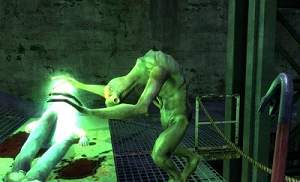
You'll find new friends and new enemies but the crowbar will always stay the same
|
In the first real action series of the game you find yourself heading down a collapsing mine and
into a slimy and dangerous antlion tunnel. These antlions are none too happy to see you, and with
their hard-hitting venom shots and thick skins they will tear you apart. In these caverns you won't
find the familiar first aid kits. Instead you can smash up antlion larvae that somehow will heal
you up. Smashing up antlions is fun but just as it starts to get routine, the environment changes
and everything is fresh again.
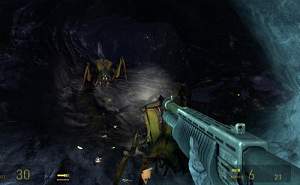
Until you get better weapons, mutant antlions can be fearsomely tough.
|
That's really my favorite part of the Episode games - it is an adrenaline rush the whole way
through with every moment either moving the story along or moving you through a battle. I don't
want to say too much about the story - it's better to experience it in game - but Half Life players
will certainly be satisfied.
There and Back Again - Portal
Half Life 2's gravity gun showed us the fun you could have with physics by tossing around pieces
of your environment. But what if you took these excellent physics a step further? What if,
instead of grabbing and throwing around objects, you could get a gun that could create portals
through the floor, the walls, the ceilings and then throw yourself through them? Portal is a game
based on this idea. The challenge isn't to kill guys or race through objectives but to solve puzzles
by making clever use of these portals.
When you start out in Portal you find yourself in your room in an experimental research facility.
Wandering out of your room/cell you begin to be guided by a somewhat evil but totally deadpan
computer voice. Armed with a portal gun that lets you place start (and later end) points, you are
faced with increasingly challenging rooms designed to test your puzzle-solving skills.
Walking through a portal on the wall and then coming out of the ceiling disoriented may have
you feeling a little dizzy, but that is nothing compared to looping through portals on floor and
ceiling to gain momentum enough to clear a gap. Like any good set of puzzles, the challenges
usually look impossible at first, but after looking at things from a different angle, the solution
becomes obvious.
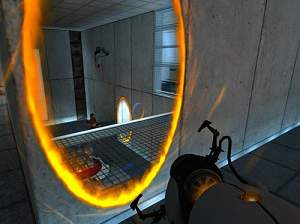
Seeing yourself through the wall can be a little disconcerting
|
Portal isn't terribly long - just a couple of hours - but the fun twists and mind-bending tricks of
gravity make for a lot of fun. Even though the concept wasn't developed at Valve (it was made
by students at Digipen, a Washington game development college), the game is imbued with the
polish and quirky humor that Valve fans have come to expect.
A New Multiplayer King - Team Fortress 2
What really makes TF2 a blast for me is the diverse set of character classes and the heavy
reliance on teamwork. In a lot of other shooters, different character classes just mean that the
main gun used by each class varies but most classes still play similarly. With TF2, each class is
hugely unique and you won't survive long without recognizing the strengths and weaknesses of
your chosen character. The nine classes are roughly divided up into offensive, defensive and
support roles - though these labels are only a loose guide.
When I first fired up TF2 I went with the scout, a speedy and opportunistic fighter. I loved being
able to get quickly to where the action was, but I often found myself running quickly into
situations I couldn't handle. My newbness at the maps also meant I often went very quickly in
the wrong direction and I racked up a whole 'lotta deaths.
Giving up on the spry scout, I decided to go to the other extreme and take the heavy for a spin.
The heavy is really the opposite of the scout in every way. I was now a tank, slow moving and
able to give and take a ton of damage. Instead of the scout's shotgun I was armed with the bulky
and brutal minigun, which was fantastic at clearing out rooms. I also found myself to be much
more involved with the team - medics took time to heal me and the teleporters dropped by
engineers became much more valuable.
Seeing how useful these support classes were, I switched over to an engineer to test out my
wrenching skills. As an engineer I tried to stay out of the heat of battle and worked to support my
team by creating teleporters to useful positions and dispensers which distribute health, ammo,
and building materials. In addition to these more benign machines I could also build turrets
which, when upgraded, can do wonders at securing positions.
Being an engineer was fun, but I also wanted to try a support role as a medic. Medics may seem
like a nice but not necessary part of virtual battlefields, but as any Brood Wars player can attest,
they can really make a difference in combat. TF2 medics' main tool is a healing gun. When used
on a teammate this gun can heal hitpoints even beyond the character's starting capacity. This
healing gun isn't clunky either - the beam will follow your allies around to some extent, and it
works very quickly.
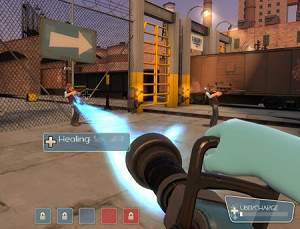
The medic, friend of warriors everywhere
|
As if being able to restore a buddy's hitpoints in a matter of seconds wasn't cool enough, the
medic also has the Ubercharge, which can be used after he has spent enough time healing on the
battlefield. Activating the Uberchage will make you and your healing target invincible for a
couple of seconds, which is perfect for breaking through an enemy strong point or making a
desperate stand at your own. As much as I loved the previous classes I played, my favorite
moments in TF2 thus far have been patching up my allies and letting loose Ubercharges to make
game-winning pushes.
In addition to these four classes there are five other, very distinct characters to play. I've yet to
really put in a lot of time with other classes but one thing that has become immediately clear is
that the best way to become useful to a team is to learn the maps well and specialize in a couple
of classes. You can later branch out your interests, but the characters are just so unique that you
can't expect to play one like another.
TF2 ships with a pretty small number of maps (just six), but they are different enough and
detailed enough that I certainly haven't felt let down. There are three pretty standard gameplay
modes: capture the flag, control points, and territory. None of them are that revolutionary, but the
game really doesn't feel incomplete in any way.
I've only just begun my TF2 career (complete with lots of statistics generated in game) but I am
hooked by the strong teamwork and diverse cast of classes. This is the best implementation of
classes I've seen in a FPS and the whole game comes together beautifully!
And Now For Something Completely Different - Peggle Extreme
While the compilation of all of these great Source-engine based games makes sense, there is one
more game in the box that just doesn't quite fit. Peggle, sort of a cross between Plinko and Puzzle
Bobble, is a ridiculously fun game that came with the preordered PC/Steam version of The
Orange Box.
When I first fired up Peggle it took all of about ten seconds to understand the concept. There is a
set of pegs and bricks arranged on the screen; by dropping a ball from the top and hoping for the
right bounces you try to take out all of the orange pegs with just 10 balls.
I was amazed at how much fun this game was despite the fact that the only input I ever had was
when to launch the ball and at what angle to send it downward. There is a little bit of timing
involved to hit moving pegs or to increase the chance that your ball lands in the moving free-ball
hole at the bottom, but really it is just about planning the right angle to launch.
While there are only ten levels to play through, you can go back and play through the levels
against yourself or against other players. You won't get more than a few hours out of the game
even with replay time, but that time is incredibly fun and left me itching for more. The whole
idea of packaging Peggle Extreme into The Orange Box was obviously to encourage you to
satiate your addiction by buying some of the regular Peggle games, but Extreme is still enough
fun to not feel like a crippled piece of trialware.
Bundling an arcade-style game into a box that is already a collection of games is a fine thing to
do, but Valve really made Peggle feel a rightful part of The Orange Box by some creative
branding. The start screen is complete with the bright colors and happy unicorn that you would
expect from a casual game like this except for just one thing... there is a Half Life headcrab
devouring the unicorn's head, complete with disturbing bone-crunching sound effects!
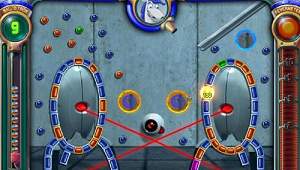
Portals make an appearance in a number of zany Peggle levels
|
The Half Life brand goes deeper through the game than just the load screen, though. The
background for each level is taken from games in The Orange Box and there are even a number
of later levels that include portals. All this branding wasn't necessary, as Peggle is still a fun
game without it, but by including it Valve made this casual arcade game into a quirky and
appropriate fit for The Orange Box.